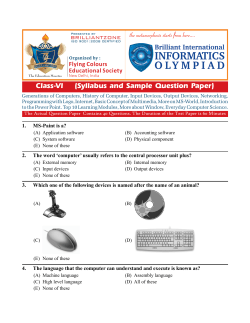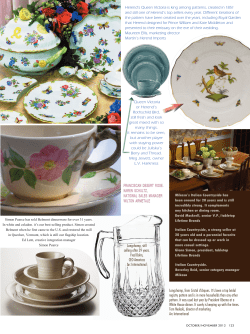
Course Intro - Interaction Design & Technologies
Tabletop Computing 2015 CIU246, 7.5 ETCS Course responsibles: Morten Fjeld and Paweł Woźniak Course Specifics Course web page: • http://ixdcth.se/courses/2015/ciu246/ • Lectures – Morten Fjeld – Paweł Woźniak – Khanh Duy Le Systems, research, and evaluation Project C# • Guest lecture – Mohammad Obaid Theme to be defined • Projects are done groupwise and run through the full course • Literature seminar, one presentation event Participation, Deadlines, Grading, and Credit Distribution Participations and deadlines • To pass the course you must participate in all activities • Deadlines and important dates are given in the schedule of course web Grading and credit distribution • The project counts for 60% of the course grade Concept 15%, realization 15%, demo 15%, and project report 15% Project report is graded based on fulfillment of “project report guidelines” Project report is written and handed in groupwise using PingPong 0213, Project, 4,0 ECTS • The individual written essay counts for 40% of the course grade Individual written essay is graded based on fulfillment of “home exam guidelines” Individual written essay is handed in individually using PingPong 0113, Written and oral assignments, 3,5 ECTS Textbook Wigdor, D., & Wixon, D. (2011). Brave NUI world: designing natural user interfaces for touch and gesture. Elsevier. Paweł will give more info on when and how to use the book during the project. Forming Groups; Working in Groups • You will be assigned into groups of 4 or 5 students. • Groups will be called Group 1, 2, 3 and 4 • We will try to capture the background and skills relevant for the course and suggest group combinations during the first course week • To change group, please suggest who you can swap with, so that this can be managed without overhead • You will work in the same groups within the project and within the literature seminar Compulsory Lectured Literature • M. Fjeld, K. Lauche, M. Bichsel, F. Voorhorst, H. Krueger & M. Rauterberg (2002): Physical and Virtual Tools: Activity Theory Applied to the Design of Groupware. In B. A. Nardi & D. F. Redmiles (eds.) A Special Issue of Computer Supported Cooperative Work (CSCW): Activity Theory and the Practice of Design, Volume 11 (1-2), pp. 153-180. • Christian Müller-Tomfelde and Morten Fjeld (2010): Introduction: A Short History of Tabletop Research, Technologies, and Products. In Müller-Tomfelde, C. (ed.) Tabletops – Horizontal Interactive Displays. Human Computer Interaction Series, Springer Verlag, pp. 1-24. • Andreas Kunz and Morten Fjeld (2010): From Table–System to Tabletop: Integrating Technology into Interactive Surfaces. In Müller-Tomfelde, C. (ed.) Tabletops – Horizontal Interactive Displays. Human Computer Interaction Series, Springer, pp. 53-72. • Holz, C. and Baudisch, P. (2011): Understanding touch. In Proceedings of CHI 2011, Vancouver, Canada, May 7-12, 2011, pp. 2501-2510. • Christian Müller-Tomfelde, Morten Fjeld (2012): Tabletops: Interactive Horizontal Displays for Ubiquitous Computing. IEEE Computer, vol. 45, no. 2, pp. 78-81. Compulsory Seminar Literature, 1/2 • Paper A: Orit Shaer, Megan Strait, Consuelo Valdes, Taili Feng, Michael Lintz, and Heidi Wang. 2011. Enhancing genomic learning through tabletop interaction. In Proceedings of the SIGCHI Conference on Human Factors in Computing Systems (CHI '11). ACM, 2817-2826. • Paper B: Gang Hu, Derek Reilly, Mohammed Alnusayri, Ben Swinden, and Qigang Gao. 2014. DT-DT: Top-down Human Activity Analysis for Interactive Surface Applications. In Proceedings of ITS '14 ACM, New York, NY, USA, 167-176. • Paper C: Orit Shaer, Ali Mazalek, Brygg Ullmer, and Miriam Konkel. 2013. From big data to insights: opportunities and challenges for TEI in genomics. In Proc. TEI '13,109-116. • Paper D: Apted, T., Collins, A. and Kay, J. Heuristics to support design of new software for interaction at tabletops. In Proc. CHI '09, 2009. Compulsory Seminar Literature, 2/2 • Paper E: Roberto Martínez Maldonado, Judy Kay, and Kalina Yacef. 2010. Collaborative concept mapping at the tabletop. In ACM ITS '10, 207-210. • Paper F: Uta Hinrichs and Sheelagh Carpendale. 2011. Gestures in the wild: studying multitouch gesture sequences on interactive tabletop exhibits. In Proceedings of the SIGCHI Conference on Human Factors in Computing Systems (CHI '11). ACM, 3023-3032. • Paper G: Halla B. Olafsdottir, Theophanis Tsandilas, and Caroline Appert. 2014. Prospective motor control on tabletops: planning grasp for multitouch interaction. In Proceedings of CHI '14. ACM, New York, NY, USA, 2893-2902. • Paper H: Nicolai Marquardt, Ricardo Jota, Saul Greenberg, and Joaquim A. Jorge. 2011. The continuous interaction space: interaction techniques unifying touch and gesture on and above a digital surface. In Proc. INTERACT’11, 461-476. Project • • • • • Themes and specifics will be introduced in course week 2 Will be done in groups (4-5 students per group) Report will be done in groups and handed in groupwise Project live demo will be done during the exam week Those without past knowledge on project planning and management (typically taught during Chalmers BSc-thesisproject), are expected to acquire basic knowledge on project management necessary to function effectively within their group. • Self-study crash-course on project management can be found here: Software and Hardware, 1/2 • The following software has been installed – Microsoft Visual C# Express 2010 – Microsoft XNA Framework Redistributable 4.0 – Microsoft® Surface® 2.0 SDK • Input Simulator to simulate touches and tags does not work with student accounts due to Windows admin policy • Installation still in progress – Microsoft Expression Blend® 4 • Software test installation on KG-237-09, Studio High • Software will be installed on a number of Student PCs at Chalmers Lindholmen during course week 1 Software and Hardware, 2/2 • • • • • Two SAMSUNG SUR40 Pixelsense devices are available The devices are not online, and should not be connected One device will be accessible at Kuggen High (or: Low) The other device will be accessible at Visual Arena Lobby Please follow “code of conduct” when using the devices For the device at the Visual Arena, Lobby: • The use of this device is only possible in the hours indicated in the course schedule • An access tag will be given to one group member per group Course Representatives Course representatives suggested by Chalmers admin.: • Alma CA • Student 2 • Student 3
© Copyright 2025











